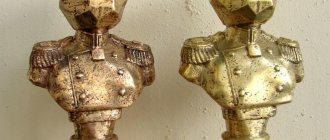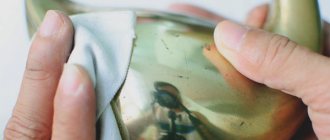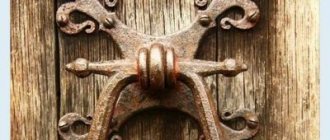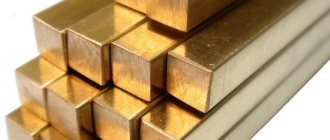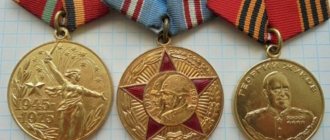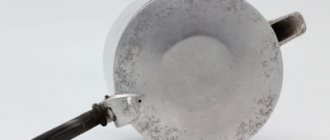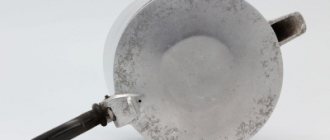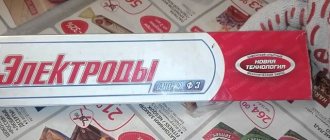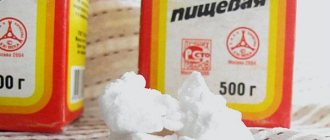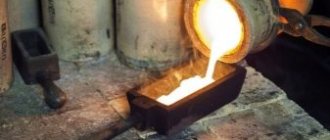What is bronze?
Before we figure out how to distinguish bronze from brass, let's find out what each alloy is. Let's start with bronze. So, bronze is an alloy of tin and copper, with admixtures of silicon, aluminum, beryllium and lead. It is the quality of the tin used that largely determines the nature of the future alloy.
There is a special type of bronze, in the manufacture of which tin is replaced with nickel or zinc. This alloy is known as spiatr. Essentially, the material is a cheap version of bronze, which is not of the best quality.
According to the above manufacturing principles, bronze is divided into tin and tin-free. At the beginning of the last century, metallurgists produced arsenic bronze. However, due to its high toxicity, the material was never widely used.
Receiving technology
Bronze is a product of alloying copper with alloying additives.
The process takes place in electric induction furnaces or crucible furnaces:
- Metals from ore or recyclable materials (household, industrial waste) are used as a source charge in the production of the material.
- The furnace is heated, coal or flux is loaded, then copper.
- The copper melt is degassed (deoxidized).
- Heated refractory components-ligatures are added.
- The mass is stirred and heated until all the contents are melted.
- A deoxidizing agent (copper phosphorous) is added again to remove copper oxides.
- The final stage of bronze production is casting into molds.
The output is flat or three-dimensional ingots. They are sent to a rolling or forging shop.
Rolled metal products: pipe, strip, circle, bushings, rod, wire.
What is brass?
Brass is practically the same alloy as bronze. But instead of the alloying composition in the form of tin, zinc is used here in combination with copper. Sometimes lead, iron, nickel, manganese, and other elements are added to the alloy.
The ancient Romans knew how to produce brass. They were the first to learn how to combine molten copper with zinc ore. Pure zinc began to be used for the production of brass only at the end of the 18th century in Britain. The British often used the alloy to create fake gold, because brass, like a noble metal, has an attractive sunny shine.
Today the material is widely used to create the so-called bimetal - an alloy where steel is combined with brass. This solution contributes to the production of metal that is resistant to corrosion and abrasion. At the same time, bimetal products have good ductility.
Is cast iron a ferrous or non-ferrous metal?
We remind you that the main difference between ferrous and non-ferrous metals is the presence or absence of magnetic properties. There are several grades of non-magnetic cast iron, for which nickel, manganese, silicon and chromium are used for alloying. The entire range of cast irons is divided into white, gray, malleable, high-strength and pig alloys. The absolute majority of them are cast irons with magnetic properties.
Cast iron is used in foundries, and only pig iron is used for subsequent steel smelting. Basically, cast iron is a ferrous metal, but non-magnetic alloys have a dual nature, which allows them to be classified as both groups of metals. By the way, some brands of alloy cast iron are also susceptible to corrosion under atmospheric influences.
The essence of materials
These metals are widely in demand today in the industrial sector. The color of brass and bronze of individual brands may be similar. However, they may differ in some of their properties. Bronze has been used by people for many thousands of years. Initially, bronze alloys were made, based on tin and copper. The metallurgical industry gradually developed, and people learned to exchange tin for other elements, such as iron, for example, or lead. Silicon, aluminum or beryllium and phosphorus could also serve as worthy alternatives. Depending on which basic materials were used, bronze can be:
- tin;
- tin-free.
The first type was used to cast bells; accordingly, it was called bell type. The chemical composition of the substance may change, but this directly affects both the color of the material and its characteristics.
The key alloying component of brass is zinc. This is a copper alloy containing manganese, iron, tin or lead. All these components may be present in minor concentrations. They are needed only to change the characteristics in one direction or another. The production of brass was known even to the inhabitants of Ancient Rome. They were able to create such a material by mixing zinc and pre-molten copper.
The most efficient production method was created in England. Scientists mixed pure zinc and molten copper. This technology was first discovered in 1781.
Brass is characterized by a golden tone. Due to its good decorative properties, it was used for a long time to produce jewelry, which was later passed off as gold. Gradually, manufacturers managed to pay attention to other, no less important parameters of brass. It turned out that it is different:
- corrosion resistance;
- plasticity;
- abrasion resistance;
- hardness;
- strength.
We recommend: Where to sell your old refrigerator for money
That is why today, as before, it is actively used in decorative products, but the range of its use does not end there. It has excellent casting properties. Accordingly, the material can be actively used in various industries.
Properties
The characteristics of the material in question are determined by two factors: composition and structure.
As noted, the chemical composition of bronze is developed in order to give it the required parameters. Some of the main ones are bronze’s ductility, hardness and strength. The first two characteristics can be varied by changing the tin concentration. Thus, its share in the composition of bronze is directly related to hardness and inversely related to ductility.
The concentration of beryllium has the greatest influence on hardness and strength. Some brands of bronze containing it are superior to steel in the second parameter. To impart ductility, the beryllium alloy is hardened. In this case, the main importance is not the quantitative indicators of the content of substances, but the severity of the properties they create. That is, with the same amount of two different elements, one of them can change the characteristics of the material to a much greater extent than the other.
Bronze microstructure
As for the structure, it determines the holding capacity of the material in relation to the elements. This can be seen using the example of tin. Thus, a single-phase structure contains up to 6 - 8% of this element. When its amount exceeds the solubility limit of 15%, the second phase of the solid solution is formed. This affects the balance of hardness and elasticity. Thus, single-phase options are more elastic, while two-phase bronze is harder, but brittle. This determines further processing: materials of the first type are suitable for forging, and two-phase alloys are suitable for casting.
Below, as an example, the main characteristics of cast tin bronze are considered. Its density is determined by the tin content and with its share of 8 - 4% it is 8.6 - 9.1 kg/cm3. The melting point is 880 - 1060°C, depending on the composition. The thermal conductivity of this material is 0.098 - 0.2 cal/(cm*s*C). This is a small value. Electrical conductivity is 0.087 - 0.176 μOhm*m, which is also not much. The corrosion rate in sea water is 0.04 mm/year, in air - 0.002 mm/year. That is, such bronze is highly resistant to it.
What is more expensive, brass or bronze?
The cost of metals on the market is almost the same. In some collection points the price of bronze may be higher than brass alloys, in others it’s the opposite. If you want to know the cost, go to the "Sell Scrap Brass" section. Considering the average market value, we can note:
- Increased demand for brass. This metal is more often used for the manufacture of household products, plumbing equipment, pipes and other common goods.
- Components. Brass alloys are mainly made using zinc, bronze alloys - with tin and a number of other additives.
- Characteristics. With properties and physico-chemical data it is more difficult. Here the parameters depend on the percentage of copper content and additional components.
Considering these factors, the demand and composition of brass metals is more in demand, therefore the average price of this metal is 10–20 rubles per kg higher than that of bronze scrap.
Where and how it is used
Bronze alloys are in demand; their range of applications ranges from critical components of equipment and infrastructure to the sphere of beauty and design.
Industry, housing and communal services
Each sphere requires alloys with different properties:
- Casting varieties, especially aluminum with its dense structure, are equipment material for working under water or in an aggressive environment (for example, acid).
- Deformable types are ordered by manufacturers of high-precision instruments.
- Electrical products are made from thermally and electrically conductive beryllium bronze. As the hardest and most plastic, it is used for membranes, springs, and tools.
- It, being immune to the amplitudes of dynamic loads, becomes the filling of on-board computers of aircraft and automobile industry products.
- For bearings operating under increased loads, lead alloy is chosen. Its advantages: ultra-low abrasion, impact resistance, strength, refractoriness.
- Products of complex shapes are made from zinc or silicon compounds. Their melts are particularly fluid; the cooled product is difficult to compress and does not spark during mechanical manipulation.
Despite the high cost, important household parts are made from bronze: fittings, taps, mixers.
Bronze is indispensable in water supply as an “inhibitor” of corrosion, bacteria, and other dangerous microflora.
What is stronger, brass or bronze?
When comparing maximum permissible loads, wear resistance and other parameters, it is important to consider that the characteristics are affected by the composition of the alloys. For comparison, it is worth taking the highest grade metals. This will help you find out how brass differs from bronze in terms of physical and chemical parameters. Having studied the data, you can note:
- Bronze is heavier. The reason is the presence of tin. Its mass is greater than that of zinc.
- The corrosion resistance of brass is lower. Bronze can come into contact with salt water with little or no effect, but brass alloys must be alloyed to reduce the effects of corrosion.
- The wear resistance of bronze products is higher, since the metal has a lower coefficient of friction.
This is interesting: Is stainless steel magnetic or not: how to determine stainless steel
Based on these properties, it can be noted that bronze is stronger than brass when considering equally high-quality alloys.
Comparative characteristics and differences between metals
In the metallurgical industry, there are clear criteria for distinguishing between bronze and brass. However, if a person is not associated with this field of activity, he will not be able to determine by eye what material is in front of him. Combining copper with tin or zinc produces alloys that have different properties and are used in specific areas.
Bronze and brass have different properties and belong to completely different categories. The first alloy can be tin or tin-free, while the second can be two- or multi-component.
Bronze alloy consists of tin to which lead may be added. The color of the metal will depend on the percentage of one element or another. The main additive element in brass is zinc.
Bronze is resistant to chemical and aggressive compounds. In addition, its negative reaction to salty sea water made it possible to use the alloy in shipbuilding and navigation. Brass cannot boast of this, so to give it improved qualities, additional elements must be introduced into the alloy. In addition, bronze has better strength and anti-friction characteristics than brass. This allows you to significantly expand the scope of application of the alloy.
The high zinc content in brass gives the alloy a variety of colors from pink-red to golden yellow. This is what makes it similar to noble gold.
What does brass look like?
The silvery-white color of bronze is achieved by adding more than 35% Sn to its composition. An alloy containing at least 85% copper is brownish-red in color. Since compounds with high levels of impurities are rare, it can be argued that basically brass is a metal of golden yellow color, and bronze is closer to red, sometimes dark brown. The same colors of brass and bronze will appear on the broken objects. This allows you to easily distinguish brass products from bronze ones.
From a metal such as brass, not only decorative elements are made, such as furniture fittings or artistic objects for interior decoration, but also main parts used in various industrial fields.
Bronze and brass have a lower melting point than pure copper. This makes it possible to make various products from them for home use. Artistic casting made of bronze and brass looks very beautiful. However, for this you need to have the appropriate equipment and know the technology and rules for performing such a procedure.
Structure and color
To determine whether brass or bronze was used to make a product, you can look at the alloys and their fracture. Brass is lighter in color and fine-grained in cut. Bronze, on the other hand, has a coarse-grained structure and is distinguished by a dark brown tint.
Materials differ in a number of characteristics. These include the following features:
- The use of tin as an alloying element in bronze, and zinc in brass. The basic component of both metals is copper.
- Bronze, including those with a traditional chemical composition, copes well with aggressive components, including salty sea water.
- To impart maximum corrosion resistance, additional alloying elements are introduced into the brass composition.
Bronze. Composition and application
Rolled products are made from this alloy: rods, reinforcement, sheets, as well as all kinds of other products, for example mesh, bearings, and any parts of various equipment. Bronze is also used in construction and architecture for the manufacture of monuments and decorative elements. In addition, this alloy finds its application in plumbing - pipes are made from it.
The main group is tin bronzes. From the name it is clear that tin is one of the main metals included in the composition. Bronze of this type is divided into two types: that for which high pressure is used, and also foundry.
Processed pressure includes Br. OCS 4-4-2.5. It contains tin in an amount of three to five percent, lead (1.5 to 3.5 percent), zinc (three to five percent), and some iron (0.05%). Everything else is copper.
The same group includes bronze, the composition of which includes from six to seven percent tin, 0.1-0.25 percent phosphorus, as well as 0.02% iron and the same amount of lead. This is Br. OF 6.5-0.15.
The next group is cast bronze. Iron supplements are not included in its composition. Bronze of this type is often used to make artistic objects, shaped items, etc.
Br. OTS6-6-3 consists of five to seven percent tin, 5.5-6.8 percent zinc and copper.
The composition of Br. OCSN3-7-5-1 contains 2.5-4.5 percent tin, 6.5-7.5 percent zinc, as well as 4.6-5.4% lead and 0.8-1.2% nickel.
Often in our time, tin began to be replaced with other metals, since it is cheaper. Such alloys form other groups.
Tin-free bronze is often of equal quality. These types are widely used in the automotive industry and other similar industries.
Comparison criteria
Despite the fact that in metallurgy there are clear criteria for distinguishing these two alloys, in real life an uninformed person is unlikely to accurately identify them.
Compound
Clear differences between metals can be traced only if the alloys do not contain impurities. However, now there are a large number of their varieties, which makes identification difficult. Brass is designated by the letter “L”; subsequent symbols in the marking indicate the presence of the main elements and the average copper content as a percentage. For example, L70 means 70% Cu content, and LAZ60-1-1 consists of 60% copper, 1% aluminum and 1% iron.
In a brass alloy, copper is combined with zinc, which gives the metal ductility and a low degree of wear resistance. This is the main additional element, but brass can be two-component or multi-component. There are different types of it.
- Deformable alloys. They are used in the production of machine parts, pipes, and springs.
- Foundries. Bearings, fittings, and devices designed to operate in conditions of elevated temperatures and aggressive environments are made from them.
- Jewelry brass. It is used to make jewelry, medals, decorative elements, and art products.
In bronze, copper is alloyed with tin, which makes the metal stronger, stronger and more durable. But sometimes aluminum, beryllium or magnesium are used instead. There are also several types of bronze.
- Tin bronze, also known as “bell” bronze. The main alloying element is tin. The alloy has good corrosion resistance and high anti-friction properties.
- Tin-free alloys. They use other components (aluminum, lead, beryllium, silicon and the like). These alloys are much softer and more ductile. The color of the material depends on the components it contains. For example, aluminum bronze has a distinctive golden-yellow color, which is why it has long been used as a substitute for gold in the production of coins and jewelry.
The most famous of the tin-free alloys is constantan. This heat-stable metal with high resistivity contains copper (about 59%) with the addition of nickel (39-41%) and manganese (1-2%).
By the way, the markings of bronze alloys do not indicate the percentage of copper, it is calculated. For example, BrA9Zh3L contains aluminum – 9% and iron – 3%. The letters “Br” mean bronze, and “L” means foundry.
Appearance
Due to its high zinc content, brass is similar in color to real gold. However, the shade directly depends on the percentage of a particular chemical element. Therefore, the spectrum of colors can vary from pink-red to golden yellow. Typically, brass appears as a yellow-golden metal.
This is interesting: Metal turning. Features of the process and necessary equipment
A bronze alloy has a silvery-white tone if it contains more than 35% tin. If its content reaches 40%, then the color of the metal is closer to white, reminiscent of steel. Products made from such bronze have a silver color with a light golden tint. If the composition contains a large proportion of copper (more than 85%), then the color of this metal is closer to red or dark brown.
Properties
Brass needs to improve its qualities, so various additional components are introduced into the alloy. Thanks to this alloying, the cast brass alloy is characterized by resistance to corrosion, low coefficient of friction, increased fluidity, low tendency to segregation, and excellent technological and mechanical properties.
Bronze has high strength properties and a low coefficient of friction. Due to its excellent resistance to the negative effects of aggressive environments, the metal is widely used in shipbuilding and shipping. Copper alloy has a wide range of applications - from decorative interior elements to critical parts.
Weight and strength
Brass is a more fragile and less durable material, prone to rapid wear. It is not used where high abrasion resistance is required. Due to the low density of zinc, brass is much lighter than bronze. Bronze is a wear-resistant and durable material. Due to its ductility, it is a favorite casting alloy for sculptors. It is much harder and stronger than brass. For example, a metal with 27% tin content is extremely hard, heavy and brittle. That is, the hardness of bronze depends on the percentage of tin in it. But this statement cannot apply to tin-free alloys.
More accurately, the specific gravity can be calculated by multiplying the density of the metal by the volume of the workpiece.
Is steel a ferrous or non-ferrous metal?
The question of whether steel belongs to ferrous or non-ferrous metals should be considered based on the classification of carbon alloys, which is provided for by many GOSTs.
According to various regulatory documents, steel is divided into the following types of ferrous metals:
- low-carbon, carbon and high-carbon alloys with a carbon content of up to 0.25; 0.25–0.6 and over 0.6%, respectively;
- low-alloy, medium-alloy and high-alloy grades of alloys with a controlled content of alloying additives up to 2.5; from 2.5 to 10 and over 10%, respectively;
- structural, tool, high-speed, corrosion-resistant, heat-resistant and other types of steel for various applications.
Of the entire extensive range of steel grades, only seven items form the group of non-magnetic alloys. We remind you that the absence of magnetic properties is the main characteristic of non-ferrous metals. At the same time, non-magnetic steel grades contain iron, which is one of the defining characteristics of ferrous metals.
Taking into account the small number of non-magnetic steels, they can be considered an exception to the general rule with an unclear status. From an ordinary point of view, it is generally accepted that ferrous metals are alloys that are susceptible to corrosion from atmospheric influences. Although high-alloy alloys can also rust.
Nuances of spectral comparative analysis
Due to the variety of copper-based alloys, it is difficult to accurately determine the type of their connection. Any of the methods to distinguish brass and bronze, even the most effective, does not provide a 100% guarantee. If you need an accurate answer to the question of what kind of alloy it is, then the only way to a reliable answer is to use spectral analysis. You can contact a scrap metal collection point, which may have the appropriate equipment.
Spectral analysis allows you to determine the chemical composition of a metal alloy based on its spectrum. In addition, this method has other advantages:
- high sensitivity;
- accuracy of results;
- studying the composition of brass and bronze products without destroying their structure;
- you can study the composition even on a small sample.
To carry out spectral analysis, a special tool is used - a steeloscope. It is designed for rapid visual qualitative and quantitative assessment of ferrous and non-ferrous alloys in the visible region of the spectrum.
Marking
Currently, there are many brands of bronze. They differ in composition, which determines their parameters and scope of application. For convenience, a marking system was created on this basis, including alphabetic and numeric symbols. Thus, alloying additives are designated by the letters first in the name of the chemical elements representing them. The numbers indicate the content of alloy components in fractions of a percent. However, these designations do not contain data on the amount of copper. This value is calculated as the difference between the total composition of bronze and the amount of alloying additives.
Bronze marking makes it easy to determine the grade required for a specific task. To do this, just use special tables. They contain data on the composition, parameters of the alloy and areas of its application.
Methods for chemical determination of alloys
Chemistry is a fairly effective way to identify brass and bronze. However, accurate results can only be obtained by reactions that destroy the metal, which will negatively affect the product. The chemical method includes the following steps:
- chips are removed from the copper alloy (so as not to damage the entire metal);
- mix a solution of nitric acid and water (in a ratio of 1:1);
- Next, you should place the chips in an acidic reagent;
- the solution is heated to boiling point after the chips are dissolved;
- The boiling temperature is maintained over low heat for half an hour.
If the shavings were brass, the solution in the container will remain transparent. When bronze dissolves, a tin precipitate (white) precipitates. Taking this into account, the method only works for bronze containing tin.
Temperature treatment of tin bronzes
In order for tin bronzes to acquire the highest ductility, they are subjected to homogenization, intermediate and final annealing. First of all, homogenization annealing is performed, which is aimed at improving the homogeneity of the alloy structure and increasing the performance properties. In this case, the unaligned intermetallic phases disappear in the solid solution, and the alloy is stabilized along the chemical cross-section of the crystallites in the tin-copper workpiece. This procedure is carried out at significantly high temperatures, reaching up to 750 degrees. After such an operation, a sharp cooling process is performed.
At the next stage, tin bronzes undergo intermediate and final annealing at a temperature not exceeding 650 degrees. These actions allow you to get rid of work hardening formed as a result of cold plastic deformation processing of tin bronzes.
How to distinguish at home?
In practice, there are several simple and proven methods to help identify metals.
How to distinguish bronze from brass using a magnet?
- When it comes to a variety of alloys, it can be quite difficult to distinguish bronze from brass, because they can be almost identical. Many experts believe that bronze is heavier than brass. This is indeed due to the content of tin and lead, which are quite heavy.
- Brass is much lighter due to the presence of zinc. You can conduct a few simple experiments to find out which metal is in front of you. Bronze is almost always magnetic due to the presence of tin.
- That is, if you apply a strong enough magnet, you will see significant magnetization. The higher the tin content in the metal, the stronger the magnetization. Brass, in turn, does not exhibit magnetic properties, that is, when a magnet is placed, it does not stick at all.
Material processing
Determination by weight
This is another method of distinguishing metals. To identify the difference, it is enough to simply weigh bars of the same volume from different alloys in your hands. A bronze specimen will weigh much heavier than a brass blank.
However, the mass of the product is also affected by the density of the connections. Therefore, it is not always recommended to use weight as a clear criterion for distinguishing metals. For example, bronze with a low tin content (2-8%) is distinguished by the fact that it will weigh lighter than its brass counterpart.
How to test bronze by heating and filing at home
We provide you with two more verification options:
- Use a gas burner as it produces the highest temperatures (up to 600 degrees). A home stove will not be enough for this operation. In addition, the experiment will have to be carried out in a separate room (workshop or garage). Take the workpiece and hold it over the fire for a long time. Bronze will not change the appearance. And dark spots will appear on the surface of the brass product.
- If you have the possibility of completely melting the original sample, then conduct such an experiment. When overheated, a white flame and scattering flakes of the same color appeared. This means that Zn burns out and you have brass. It has good ductility. During deformation, it will not lose its physical properties, but bronze will certainly crumble and break if overheated.
- Sawing is the most affordable method that you can do at home without financial costs. Take a hacksaw and try to saw off samples. The brass product can be sawed well and easily, thereby forming layers. The shavings will have a twisted appearance. Metal containing tin when exposed to a sharp object will break into small pieces, producing fine dust. If you try to bend or flatten the sample, you will not achieve a positive result; you will only ruin the workpiece.
This is interesting: Cutting internal and external threads with your own hands
Drill Usage and Marking
Using a drill you can easily identify brass. But it is important to remember that the tool will damage the metal object. The fact is that during operation of the drill, chips come out from under the drill, which for copper are quite long and ornate, while for brass they are, on the contrary, short and needle-shaped. After all, the metal is much softer than its alloy.
Sometimes on a piece of the material being examined you can see markings that can easily tell you what is in front of a person. So, the mark on copper begins with the letter “M”, and on brass - with “L”. But in other countries, product labeling is somewhat different from Russian:
- In the USA you can see C2, C3, C4 badges on brass alloy.
- In the European Union, the letter C is placed on copper and brass, but after it on the metal you can see A, B, C, D, and on the alloy - L, M, N, P, R.
This method makes it quite easy to distinguish pure copper from brass. If markings are present, then you should not resort to other recognition methods.
Advantages and disadvantages
Bronze has many positive qualities. Among them:
- variety of properties and, consequently, areas of application;
- the ability to create options for various processing methods (casting or deformation) depending on needs;
- slight shrinkage (0.5 - 1.5%);
- the possibility of repeated processing without loss of properties, that is, bronze can be processed;
- high resistance to chemical influences of the environment (water, air, acids);
- greater elasticity of many options.
The main disadvantage is the high cost of some brands, for example, tin bronze. Types of other composition, such as aluminum alloy, are much cheaper. Thus, the cost of the materials under consideration is largely determined by the alloying elements included in their composition.
Differences in the nature of the fracture and evaluation of the finished product
Many people will even say, why bother figuring out whether it’s brass or copper if the two alloys look almost the same? But the fact is that this is important for many, in particular for people who will be involved in making some kind of sculptures or melting them down. Accordingly, very often a distinction is required if you are going to sell metal for scrap.
The fact is that brass is cheaper than bronze, so at a metal collection point they can simply deceive you and offer you a smaller amount. If the weight is small, then the losses will be insignificant, but if you have a fairly large amount of goods, then you will lose a decent amount of money. It is worth noting that there is no need to conduct tests, just look at the finished products. Brass is almost never used in shipping.
Locksmith tool
This material is destroyed when exposed to sea salt water, so compasses and some parts in shipbuilding are used exclusively in bronze. Therefore, if they are trying to deceive you, insist on checking the product, or contact a certified center. They usually have collection points as well as small compact laboratories. They can conduct a quick, simple analysis and analyze the product using laboratory equipment.
It is quite easy to distinguish between metals when viewing the fracture site. Brass breaks in fairly small grains, bronze breaks off in large pieces and has a coarse grain. At the same time, the color of the bronze fracture has a reddish tint; if it is brass, then it has a whitish or yellowish tint.
Accessories skull
Unfortunately, these methods cannot be used at home due to the lack of laboratory equipment. Magnet and chip tests are available for home users. They are also very informative.
Why was zinc added to copper and why are zinc statues not cast?
Copper is alloyed with zinc to create alloys with properties that copper and zinc do not have individually. Copper is a good conductor of heat and electricity. Copper is ductile, stretches, and can be stamped. Copper wires, copper tubes for refrigerators, heaters or air conditioners, copper utensils fully realize the properties of copper, such as heat and electrical conductivity, and high ductility. Corrosion resistance and chemical inertness to household solutions make it possible to produce copper cookware, frying pans, and pots. But the downside of the properties of copper is that it has insufficient strength, hardness, corrosion resistance and high cost for widespread use in technology as a structural material. For five thousand years, people have been modifying copper by adding other metals to the melt to measure its properties.
Story
The alloy was the first to be produced by people - the production of bronze was established by the middle of the 5th millennium BC. For more than two thousand years it was the number one material; this era in the history of the planet is called the “Bronze Age”.
Temporal parameters of the Bronze Age - XXXIV - XII centuries BC.
The first items excavated by archaeologists date back to the fifth millennium BC:
- The main components then were copper and arsenic. They served utilitarian purposes: dishes, tools, weapons.
- The Egyptians and Middle Easterners replaced arsenic with tin. Having seen the aesthetics of the material, they used it as decoration.
Arsenic bronze turned out to be toxic, fragile, and expensive. It was replaced by tin alloy.
- Coins were minted from the material.
- Sculptors of Ancient Greece created large-sized statues.
- Since the Middle Ages, the main purpose of the alloy has been “military industry”. Bronze cannons and cannonballs were an attribute of all subsequent wars.
Bronze alloy is a traditional material for church bells. By varying the dimensions of the product and the composition of bronze, craftsmen achieve the sound of the desired tonality.
Application area
Bronze is more durable. Based on it, you can create decorative elements of increased strength that can last for a long time. It is used for various industrial sectors when it is necessary to produce reliable parts. Brass is more often used in the manufacture of metal elements with high corrosion resistance.
Compared to copper, bronze and brass have a lower melting point. This property can be used to make various products with your own hands. True, you will have to stock up on the appropriate tools and equipment. It is also important to adhere to the rules of technological operations and study casting technology.
Sources
- https://titan-spec.ru/harakteristiki/sostav-bronzy-i-latuni-otlichie.html
- https://sdaymetall.ru/stati/kak-otlichit-bronzu-ot-latuni/
- https://1nerudnyi.ru/latun-i-bronza-01/
- https://intehstroy-spb.ru/spravochnik/kak-otlichit-latun-i-bronzu-v-domashnih-usloviyah.html
- https://vplate.ru/metally-i-splavy/bronzu-ot-latuni/
- https://metallolom-msk.ru/kak-otlichit-latun-ot-bronzy.html
- https://molotok34.ru/spravochnik/kak-otlichit-bronzu-ot-latuni.html
- https://www.rocta.ru/info/kak-otlichit-bronzu-ot-latuni-proverka-v-domashnikh-usloviyakh/
- https://msmetall.ru/metally/bronza-i-latun-raznica.html

